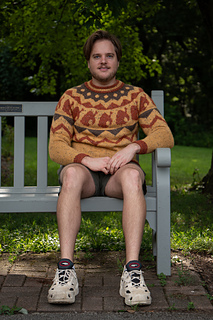patterns >  Chase Harpole's Ravelry Store
Chase Harpole's Ravelry Store
> Tomnooki














Tomnooki
When you purchase Tomnooki, the PDFs for Tomnooki Lite (the fingering-weight version) will be included with your purchase!
Tomnooki is a seamless, top-down, circular yoke pullover inspired by an in-game item from the video game Animal Crossing: New Horizons for the Nintendo Switch. The yoke is worked using stranded colorwork and the ladderback jacquard technique to catch large floats.
Only two-colors are worked with at a time in the stranded colorwork. After the yoke is worked, the colorwork extends into the first part of the body and sleeves. This extension creates an oversized proportion that is similar to how the item looks when worn by villagers in the game. The colorwork for this pattern is only charted because each size has their own individual yoke chart to ensure a well-fitting yoke depth.
Tomnooki includes 10 sizes with a finished chest circumference of 32” to 68” (81.5 to 172.5 cm). This pattern also features gender-inclusive sizing. For each of these 10 sizes, two sizes are graded based on shoulder widths, which is one of the primary ways bodies proportionally vary for those with the same chest size. This means there are 20 unique sizes in this pattern.
Choose to make the Narrow Shoulder size if the recipient finds that the shoulders on womenswear garments fits them well or the shoulders of menswear garments are too wide. Make the Broad Shoulder size if the recipient finds that the shoulders on menswear garments fits them well or the shoulders on womenswear garments are too narrow. If the recipient is unsure, choose the size that is closest to their cross back measurement for their desired chest size.
The pullover begins with the yoke set-up. Short rows are added at the neck to raise the back neck proportional to the front. The colorwork is worked via charted instructions for your individual size. After the yoke is worked, the body and sleeves are separated. The colorwork extends into the body and then transitions into Stockinette stitch through the hem where 1x1 ribbing is worked in a contrasting color. The colorwork also extends into the sleeves and is worked using a chart for your size. The sleeves are then shaped through to the cuff and 1x1 rib is worked through in the cuff in a contrasting color. Finally, the collar is picked up and worked in a stripe motif in 1x1 rib.
Here is list of all the options presented in the pattern:
- Cropped or full body lengths
- 2 different instructions for full sleeves
- 2 different instructions for body lengths
View full schematics, sizing guide, and options explanation here: https://drive.google.com/file/d/1OXefp6t6DZtR4moWBjE7UpLdagR7YKRe/view?usp=sharing
Sizes
1 (2, 3, 4) (5, 6, 7) (8, 9, 10)
Measurements
Finished chest measurement: 32 (36, 40, 44) (48, 52, 56) (60, 64, 68)”/81.5 (91.5, 101.5, 112) (122, 132, 142) (152.5, 162.5, 172.5) cm.
Recommended 4 to 8” (10 to 20 cm) of positive ease through the chest. Sample is worn with 4” (10 cm) of positive ease through the full chest.
Suggested Yarn
Knit Picks City Tweed™ DK (55% Merino Wool,
25% Superfine Alpaca, 20% Donegal Tweed), 123
yds (112 m)/50 g in
Broad Shoulder
MC: Lemon Curd, 10 (10, 12, 13) (14, 16, 17) (19, 20, 21) skeins
CC1: Habanero, 3 (3, 3, 3) (4, 4, 4) (4, 4, 5) skeins
CC2: Tabby, 1 (1, 2, 2) (2, 2, 2) (2, 2, 2) skeins
Narrow Shoulder
MC: Lemon Curd, 9 (10, 11, 12) (14, 15, 16) (18, 19, 20) skeins
CC1: Habanero, 2 (3, 3, 3) (3, 3, 4) (4, 4, 4) skeins
CC2: Tabby, 1 (1, 1, 2) (2, 2, 2) (2, 2, 2) skeins
Yardage
DK weight
Broad Shoulder Yardage
MC: 1110 (1220, 1400, 1550) (1680, 1880, 2050) (2250, 2400, 2550) yds/ 1015 (1116, 1280, 1417) (1536, 1719, 1875) (2057, 2195, 2332) m
CC1: 270 (300, 330, 350) (375, 400, 425) (450, 480, 500) yds/ 247 (274, 302, 320) (343, 366, 389) (411, 439, 457) m
CC2: 100 (115, 130, 145) (160, 175, 190) (205, 220, 235) yds/ 91 (105, 119, 133) (146, 160, 174) (187, 201, 215) m
Narrow Shoulder Yardage
MC: 990 (1120, 1280, 1430) (1600, 1750, 1920)
(2100, 2250, 2390) yds/ 905 (1024, 1170, 1308) (1463, 1600, 1756) (1920, 2057, 2185) m
CC1: 230 (260, 290, 310) (335, 360, 385) (410,
440, 460) yds/210 (238, 265, 283) (306, 329, 352) (375, 402, 421) m
CC2: 80 (95, 110, 125) (140, 155, 170) (185, 200,
215) yds/ 73 (87, 101, 114) (128, 142, 155) (169, 183, 197) m
Sample Needles
Main needle: US 5 (3.75 mm)or size needed to achieve gauge in 24” (60 cm), 32 to 60” (80 to 150 cm) to match body circumference, and DPNs.
Smaller Needle: US 4 (3.5 mm)or size needed to achieve gauge in 16” (40 cm), 32 to 60” (80 to 150 cm) to match body circumference, and DPNs.
Gauge
20 sts x 28 rows = 4”/ 10cm in St. st and stranded colorwork, in-the-round, blocked on US 5 (3.75 mm) needle or size needed to achieve gauge.
Notions
Scissors
Tapestry needle
Stitch markers
Scrap yarn/holder
Featured Techniques
Knitting
Purling
Picking up Stitches
Increasing
Decreasing
German short rows
Stranded Colorwork
Ladderback Jacquard
15042 projects
stashed
12742 times
- First published: May 2020
- Page created: September 18, 2020
- Last updated: December 1, 2025 …
- visits in the last 24 hours
- visitors right now




